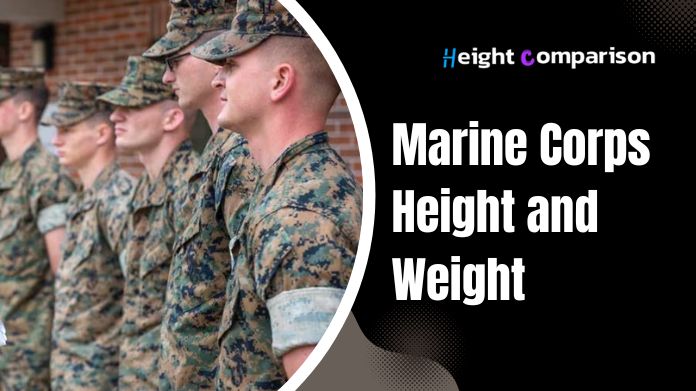The United States Marine Corps (USMC) sets specific standards for height and weight as part of its fitness and readiness requirements. Understanding the Marine Corps height and weight charts standards is essential for individuals aspiring to join or serve in the Marine Corps. These standards ensure that Marines maintain optimal physical fitness, health, and operational readiness.
In this Height Comparison guide, we will explore the height and weight requirements established by the Marine Corps, including the criteria for both males and females. We’ll delve into the importance of meeting these standards for overall fitness and performance in military duties.
Additionally, we’ll discuss how deviations from these standards may impact a Marine’s career and what measures are in place to support Marines in maintaining their physical readiness.
By understanding the Marine Corps height and weight standards, individuals can better prepare for military service or strive to meet and maintain these standards as active-duty Marines.
Let’s explore the details of the Marine Corps height and weight charts and their significance in maintaining a strong and capable military force.
Marine Corps Weight Limits
To achieve fitness, a Marine must maintain a body mass 25% lower than the measurement made at the time of enlistment. Marines weigh between 160 and 170 pounds on average.
To assess whether an individual falls into the “normal,” “ideal weight,” or “overweight” categories, the Marine Corps utilizes the Body Mass Index (BMI) formula.
Marine Corps Height Requirements
Within the Marine Corps, the minimum height requirements differ depending on the service. In the field, a male Marine’s average height is 5’9″, while a female Marine’s average height is 5’4″. Should you fall short of these minimum height standards, your training may be put on hold until you reach the required height.
Marine Corps Height and Weight Chart

Here is a Marine Corps height and weight chart in Markdown format:
| Height (inches) | Minimum Weight (lbs) | Maximum Weight (lbs) |
|---|---|---|
| 58 | 91 | 131 |
| 59 | 94 | 136 |
| 60 | 97 | 141 |
| 61 | 100 | 146 |
| 62 | 104 | 151 |
| 63 | 107 | 156 |
| 64 | 110 | 161 |
| 65 | 114 | 166 |
| 66 | 117 | 171 |
| 67 | 121 | 176 |
| 68 | 125 | 181 |
| 69 | 128 | 186 |
| 70 | 132 | 192 |
| 71 | 136 | 197 |
| 72 | 140 | 203 |
| 73 | 144 | 208 |
| 74 | 148 | 214 |
| 75 | 152 | 220 |
| 76 | 156 | 225 |
| 77 | 160 | 231 |
| 78 | 164 | 237 |
| 79 | 168 | 244 |
| 80 | 173 | 250 |
Note:
- Height is measured in inches without shoes.
- Weight is measured in pounds with PT uniform only (no shoes).
- Marines who exceed the maximum or fall below the minimum weight for their height are taped to determine body fat percentage.
- Body fat percentage standards: 18% for males, 26% for females.
The height and weight standards ensure Marines maintain a healthy body composition and physical readiness for the demands of military service. Those exceeding the maximum weight for their height are measured to assess body fat percentage. If body fat exceeds standards, the Marine is enrolled in a Body Composition Program to lose excess fat and meet the standards.
Final Note
The Marine Corps height and weight chart is essential in maintaining Marines’ physical fitness, health, and readiness. These standards are based on height, age, and gender, ensuring Marines are prepared for the demanding tasks and challenges they may face.
Adhering to the height and weight requirements set by the Marine Corps is not only about meeting a standard; it’s about maintaining optimal fitness levels that directly impact performance, agility, and overall effectiveness in military operations. Deviations from these standards can impact an individual’s career progression and may require remedial actions or additional training.
It’s essential for individuals aspiring to join the Marine Corps and current Marines to understand and strive to meet these standards. Regular physical training, healthy lifestyle choices, and proper nutrition are key components in maintaining physical readiness and meeting the height and weight requirements set by the Marine Corps.
By upholding these standards, Marines contribute to the overall readiness and effectiveness of the Marine Corps as a strong and capable military force ready to serve and protect the nation’s interests.






